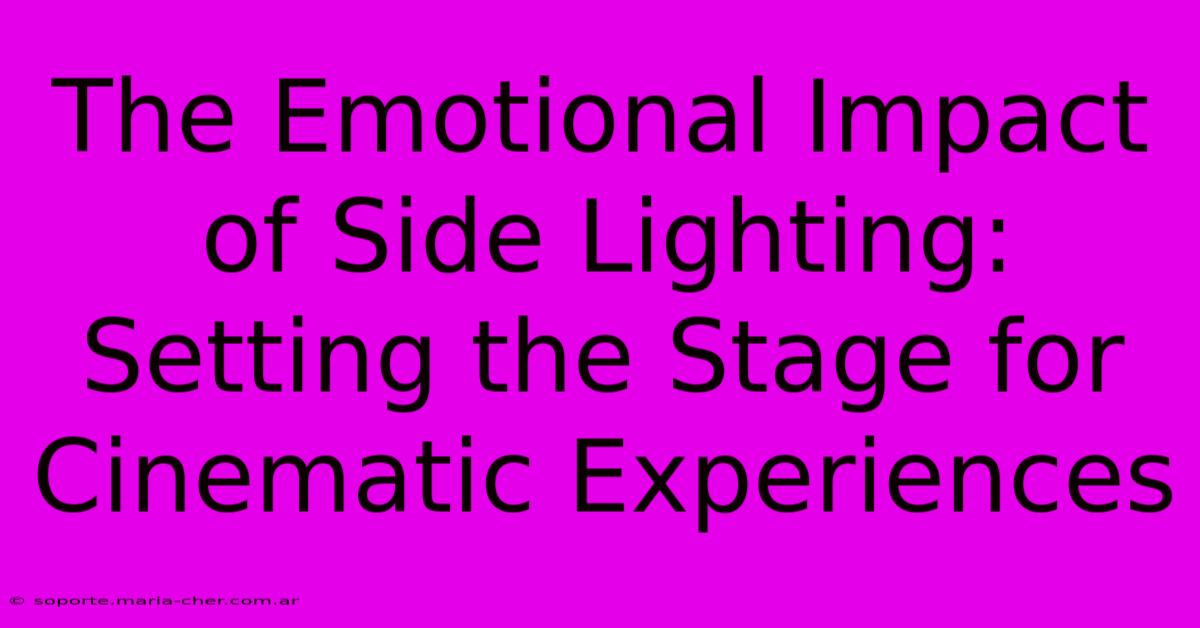The Emotional Impact Of Side Lighting: Setting The Stage For Cinematic Experiences

Table of Contents
The Emotional Impact of Side Lighting: Setting the Stage for Cinematic Experiences
Side lighting. It's more than just a technical term for cinematographers; it's a powerful tool capable of evoking a wide spectrum of emotions in the viewer. Understanding how side lighting works and its subtle nuances can significantly elevate your filmmaking, photography, or even your home design. This article delves into the emotional impact of side lighting and explores how it sets the stage for truly cinematic experiences.
The Power of Shadows and Highlights
Side lighting, unlike front lighting which evenly illuminates a subject, uses light sources positioned to one side. This creates a dramatic interplay of light and shadow, fundamentally altering the mood and perceived character of a scene. The resulting chiaroscuro effect – the stark contrast between light and dark – is a cornerstone of cinematic storytelling.
Creating Depth and Dimension
One of the most significant contributions of side lighting is its ability to add depth and dimension to a scene. The shadows it casts define form, texture, and volume, providing a visual richness that flat lighting simply cannot achieve. This three-dimensionality engages the viewer on a deeper level, drawing them into the narrative.
Evoking Specific Emotions
The emotional impact of side lighting is incredibly versatile. Consider these examples:
-
Mystery and Suspense: Side lighting, especially when used with low-key lighting (a lot of shadow), can create an atmosphere of mystery and suspense. The obscured areas conceal details, triggering the viewer's imagination and heightening their anticipation. Think of classic film noir – the shadows conceal secrets, mirroring the shadowy nature of the characters themselves.
-
Romance and Intimacy: Soft, diffused side lighting can create a romantic and intimate ambiance. The subtle shadows can add a sense of mystery and allure, enhancing the emotional connection between subjects.
-
Drama and Conflict: Hard, directional side lighting can emphasize conflict and drama. The harsh shadows create a sense of tension and unease, mirroring the inner turmoil of characters or the intensity of the situation.
-
Hope and Serenity: Side lighting, when combined with warm color temperatures, can evoke feelings of hope and serenity, especially when used on a character's face. A gentle highlight on one side of the face can suggest inner peace or optimism.
Mastering the Art of Side Lighting
Effectively utilizing side lighting requires careful consideration of several factors:
Light Source and Quality
The type of light source significantly impacts the overall effect. Hard light (e.g., sunlight, bare bulb) creates sharp, defined shadows, while soft light (e.g., diffused sunlight, softboxes) produces gentler, more subtle shadows.
Angle and Intensity
The angle of the light source relative to the subject determines the shadow's direction and length. A lower angle creates longer shadows, adding to the dramatic effect, while a higher angle produces shorter shadows. The intensity of the light also plays a crucial role in the overall mood.
Background and Reflections
The background and reflective surfaces within the scene will also influence the shadow patterns and highlight placement, adding further layers of depth and visual interest. Be mindful of these elements to ensure the lighting complements, rather than detracts from, the overall scene.
Beyond Film: Applying Side Lighting Principles
The principles of side lighting aren't limited to filmmaking. Photographers, interior designers, and even stage lighting designers leverage this technique to create visually compelling and emotionally resonant environments. Understanding how to strategically manipulate light and shadow opens up a world of creative possibilities.
In Conclusion:
Side lighting is a potent tool for manipulating emotion and enhancing visual storytelling. By carefully controlling the light source, angle, and intensity, you can create a wide range of moods and atmospheres. Mastering this technique is key to elevating your creative projects and crafting truly cinematic experiences. Experiment with different techniques and observe how side lighting transforms your images and scenes, unlocking the power of light and shadow to tell your story more effectively.

Thank you for visiting our website wich cover about The Emotional Impact Of Side Lighting: Setting The Stage For Cinematic Experiences. We hope the information provided has been useful to you. Feel free to contact us if you have any questions or need further assistance. See you next time and dont miss to bookmark.
Featured Posts
-
Amd Stock Price After Earnings Dip
Feb 05, 2025
-
Declarations Trump Sur Gaza
Feb 05, 2025
-
Natures Color Symphony Witness The Harmony Of Green And Yellows Duet
Feb 05, 2025
-
Harnessing Light And Shadow Why Movie Directors Swear By Side Lighting
Feb 05, 2025
-
The Symphony Of Art The Morgan Library And Museums Exhibition Marries Music And Literature In Harmony
Feb 05, 2025
